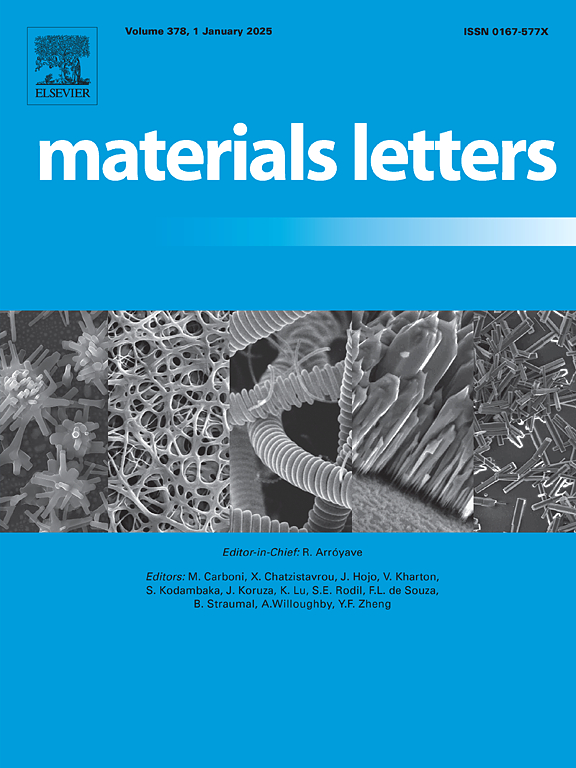以钛粉和石墨粉为原料,采用超快高温烧结技术快速合成碳化钛
IF 2.7
4区 材料科学
Q3 MATERIALS SCIENCE, MULTIDISCIPLINARY
引用次数: 0
摘要
自传播高温合成(SHS)是一种基于燃烧的自加热链式反应方法,可快速生产高熔点材料。采用超快高温烧结(UHS)技术,对钛粉和石墨粉制备的碳化钛(TiC)进行了超快高温烧结,研究了烧结过程中的产热和显微组织演变。证实了TiC合成过程中产生的放热,表明在UHS的初始阶段产生了SHS。在钛熔点以上,随着超高压温度的升高,超高压点火前的孵育时间缩短。扫描电镜显示,在高温高温下形成了细小的TiC颗粒,在持续的超高压下,TiC颗粒变得更加致密。此外,熔融Ti在SHS过程中散布在石墨颗粒上,在随后的UHS加热下,石墨颗粒转变为板状TiC颗粒,它们之间有细长的空隙。发现这种结构特征阻碍了进一步致密化。本文章由计算机程序翻译,如有差异,请以英文原文为准。
Rapid titanium carbide synthesis from titanium and graphite powders via ultrafast high-temperature sintering
Self-propagating high-temperature synthesis (SHS) is a combustion-based method that involves a self-heating chain reaction, which is effective for rapidly producing materials with high melting points. Herein, ultrafast high-temperature sintering (UHS) was leveraged to ignite the SHS of titanium carbide (TiC) from titanium and graphite powders, and the heat generation and microstructural evolution during the process were investigated. The exothermic heat generated during TiC synthesis was confirmed, demonstrating that SHS was initiated in the initial stage of UHS. The incubation time before SHS ignition decreased with an increase in the UHS temperature above the melting point of titanium. Scanning electron microscopy revealed that fine TiC grains formed during SHS, which became denser under continued UHS. Additionally, molten Ti spread over the graphite particles during SHS, which transformed into plate-like TiC grains with elongated voids between them under subsequent heating by UHS. This structural feature was found to hinder further densification.
求助全文
通过发布文献求助,成功后即可免费获取论文全文。
去求助
来源期刊

Materials Letters
工程技术-材料科学:综合
CiteScore
5.60
自引率
3.30%
发文量
1948
审稿时长
50 days
期刊介绍:
Materials Letters has an open access mirror journal Materials Letters: X, sharing the same aims and scope, editorial team, submission system and rigorous peer review.
Materials Letters is dedicated to publishing novel, cutting edge reports of broad interest to the materials community. The journal provides a forum for materials scientists and engineers, physicists, and chemists to rapidly communicate on the most important topics in the field of materials.
Contributions include, but are not limited to, a variety of topics such as:
• Materials - Metals and alloys, amorphous solids, ceramics, composites, polymers, semiconductors
• Applications - Structural, opto-electronic, magnetic, medical, MEMS, sensors, smart
• Characterization - Analytical, microscopy, scanning probes, nanoscopic, optical, electrical, magnetic, acoustic, spectroscopic, diffraction
• Novel Materials - Micro and nanostructures (nanowires, nanotubes, nanoparticles), nanocomposites, thin films, superlattices, quantum dots.
• Processing - Crystal growth, thin film processing, sol-gel processing, mechanical processing, assembly, nanocrystalline processing.
• Properties - Mechanical, magnetic, optical, electrical, ferroelectric, thermal, interfacial, transport, thermodynamic
• Synthesis - Quenching, solid state, solidification, solution synthesis, vapor deposition, high pressure, explosive
 求助内容:
求助内容: 应助结果提醒方式:
应助结果提醒方式:


